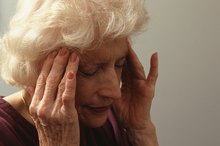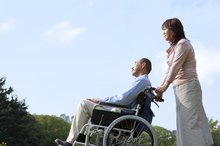Causes of Temporary Leg Paralysis
Temporary leg paralysis is a distressing symptom, which varies in severity from leg weakness to complete loss of movement in the affected limb. Abnormalities that affect the brain or nerves that control the leg muscles can cause temporary leg paralysis. The development of temporary leg paralysis requires urgent medical evaluation, as this symptom may serve as a warning sign of a potentially life-threatening condition.
If you are experiencing serious medical symptoms, seek emergency treatment immediately.
TIA
A transient ischemic attack, or TIA, reflects a brief episode of reduced blood supply to an area of the brain. A TIA involving the area of the brain that controls the leg can cause temporary leg paralysis. TIA symptoms characteristically resolve without permanent damage when normal blood flow resumes, which typically occurs within one to 24 hours. Importantly, a TIA may signal an impending stroke. Approximately 33 percent of people who have a TIA experience a future stroke, reports the National Institute of Neurological Disorders and Stroke 2.
- A transient ischemic attack, or TIA, reflects a brief episode of reduced blood supply to an area of the brain.
Stroke
The Medical Conditions That Cause Weakness on the Left Side of the Body
Learn More
An interruption in brain blood flow that results in a localized area of brain cell death constitutes a stroke. When the area of the brain that controls the leg is involved in a stroke, leg paralysis characteristically develops. Most strokes occur due to a blood clot that blocks an artery supplying blood to the brain, reports the Centers for Disease Control and Prevention 1. Approximately 795,000 strokes occur each year in the United States, according to CDC.
- An interruption in brain blood flow that results in a localized area of brain cell death constitutes a stroke.
- Most strokes occur due to a blood clot that blocks an artery supplying blood to the brain, reports the Centers for Disease Control and Prevention 1.
Guillain-Barré Syndrome
Guillain-Barré syndrome, also known as acute inflammatory demyelinating polyneuropathy, represents an immune system attack on the insulating covering of the nerves 3. Destruction of this covering, called myelin, interferes with the transmission of nerve signals to the muscles, leading to temporary paralysis. According to the patient information website the Doctors of USC, Guillain-Barré syndrome most frequently occurs a few days to weeks after a bacterial or viral infection. Common preceding bacterial infections include those caused by Campylobacter jejuni, Haemophilus influenzae and Mycoplasma pneumoniae. Viral infections that may precipitate Guillain-Barré syndrome include those caused by the hepatitis A or B virus, Epstein-Barr virus, cytomegalovirus and HIV. The National Institute of Neurological Disorders and Stroke reports that leg weakness and tingling represent the most common presenting symptoms of Guillain-Barré syndrome 2. Paralysis typically progress up the body, involving the muscles of the trunk and arms. In severe cases, paralysis may be nearly complete. Most patients with Guillain-Barré syndrome experience a full recovery, although residual weakness may persist in some people.
- Guillain-Barré syndrome, also known as acute inflammatory demyelinating polyneuropathy, represents an immune system attack on the insulating covering of the nerves 3.
- Most patients with Guillain-Barré syndrome experience a full recovery, although residual weakness may persist in some people.
Related Articles
References
- Centers for Disease Control and Prevention: Types of Stroke
- National Institute of Neurological Disorders and Stroke: Guillain-Barré Syndrome
- Yuen T. So, Continuum: Peripheral Neuropathies, Immune-Mediated Neuropathies, Volume 18, Number 1, February 2012.
- Braunwald E, Fauci ES, et al. Harrison's Principles of Internal Medicine. 16th ed. 2005.
Writer Bio
Dr. Tina M. St. John owns and operates a health communications and consulting firm. She is also an accomplished medical writer and editor, and was formerly a senior medical officer with the U.S. Centers for Disease Control and Prevention. St. John holds an M.D. from Emory University School of Medicine.








